new posts in all blogs
Viewing: Blog Posts Tagged with: Hal Roach, Most Recent at Top [Help]
Results 1 - 9 of 9
How to use this Page
You are viewing the most recent posts tagged with the words: Hal Roach in the JacketFlap blog reader. What is a tag? Think of a tag as a keyword or category label. Tags can both help you find posts on JacketFlap.com as well as provide an easy way for you to "remember" and classify posts for later recall. Try adding a tag yourself by clicking "Add a tag" below a post's header. Scroll down through the list of Recent Posts in the left column and click on a post title that sounds interesting. You can view all posts from a specific blog by clicking the Blog name in the right column, or you can click a 'More Posts from this Blog' link in any individual post.

By: Kathy Temean,
on 11/1/2014
Blog:
Writing and Illustrating
(
Login to Add to MyJacketFlap)
JacketFlap tags:
Poems,
Kelly Fineman,
Competition,
authors and illustrators,
Win,
Vivian Kirkfield,
Carol Murray,
Carol MacAllister,
Donna Weidner,
Jane Resides,
Pia Garneau,
Robert Zammarchi,
Wendy Greenley,
Carol Jones,
Poll - Vote,
Add a tag
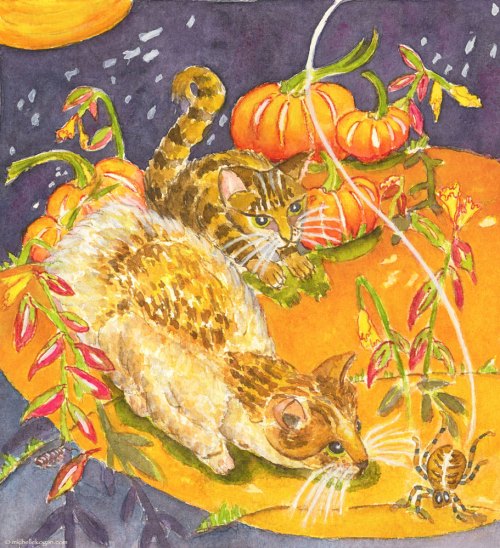
Almost missed sharing this wonderful illustration sent in by Michelle Kogan. She is an illustrator/painter/instructor and writer from the Chicago area. Here is her website: www.michellekogan.com Her cards are available in her Etsy shop – www.MichelleKoganFineArt.etsy.com
Last Thursday I posted the Halloween Poems sent in for the holiday. I was impressed with the talent out in the audience and will repeat this for other holidays. I decided to create a poll and let everyone chose their favorite poem. I left out Eileen Spinelli on purpose.
I will give the winner of the favorite Halloween poem a chance to be interviewed by me on this blog and show off their work: Book, illustrations, Poems. The winner can hold on to the win for when their book comes out or they can use it immediately. So if you had a poem on last Thursday’s post or have a friend who had their poem posted on October 30th, vote and tell all your friends to vote, too.
Click here to read the poems:
Voting is open until November 9th.
Take Our Poll
Talk tomorrow,
Kathy
Filed under:
authors and illustrators,
Competition,
Poems,
Win Tagged:
Carol Jones,
Carol MacAllister,
Carol Murray,
Donna Weidner,
Jane Resides,
Kelly Fineman,
Pia Garneau,
Poll - Vote,
Robert Zammarchi,
Vivian Kirkfield,
Wendy Greenley 

Tanya Lee Stone. Susan Goodman. Jim Murphy. Kelly Fineman. You know these folks. They’re regular contributors to this blog. They’re also four of the thirty or so authors featured in Real Revision by award-winning children’s book author Kate Messner. The book is such a gem that you’ll definitely want your very own copy.Real Revision is published by Stenhouse Publisher, which caters to educators, so this book is written specifically for teachers. That makes it great for all you educators out there. But I know plenty of writers also read this blog. This book is a MUST READ for you, too.Some chapters focus on fiction-specific revision strategies, but the lion share of the book is useful to nonfiction writers as well. Here are few of my favorite quotations from nonfiction writers.Kelly Fineman on why she takes time away from a manuscript between writing the rough draft and delving into the revisions: “It could be as little as half an hour or as long as a year, but I need to have established some sort of distance from it in order to read it at least somewhat objectively and not like a doting author.”Loree Griffin Burns on the importance of reading widely and carefully considering the structure of nonfiction writing: “I pay close attention to the structure of the books I am reading all the time, and I compare and contrast them to the structure I’m working with. This is always helpful to me because it gives me confidence . . .or in some cases, helps me see why my own structure is not working.”Susan Goodman on striking the right balance between sharing information and engaging readers while writing Life on the Ice:“. . . I was trying to fit in so many facts that I had lost sight of what my book was all about—the excitement on exploration . . . So I sat down at my computer with an imaginary nine-year-old kid beside me. And I simply told that kid an adventure story—one where scientists were the explorers.”Jim Murphy on finding the proper voice and storytelling technique for his Newbery Honor book The Great Fire. “I read newspapers and personal recollections of the Chicago fire until I had absorbed the pace and language of the era. . . . I didn’t try to duplicate voices from the past, but I knew I had a faint echo of them in my style.”Tanya
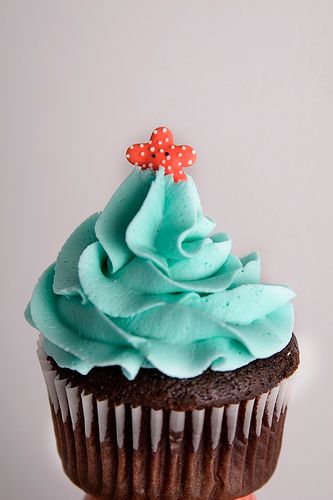
Dancing Starfish cupcake by Cape Cod Cupcake Co.
Dear Kelly Ramsdell Fineman,
Congratulations on the publication of your beautiful poem, "Troubled Water," in Breaking Waves: An Anthology for Gulf Coast Relief! It's hands down our favorite piece, by virtue of its exquisite language and powerful, heartbreaking message.
Thank you so much for contributing your work in support of such a worthwhile cause. We are very proud to know you!
Your loyal fans,
the alphabet soup kitchen helpers
xxxooo
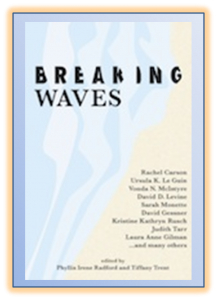
P.S. Note to everybody out there: For just $4.99, you can purchase the e-book, Breaking Waves, a collection of 34 poems, essays, short stories and articles edited by Tiffany Trent and Phyllis Irene Radford. It includes an excerpt from Rachel Carson's,The Sea Around Us, begins with Ursula K. Le Guin's poem, "In England in the Fifties," and ends with Kelly's poem, "Troubled Water." 100% of the proceeds from the sale of this anthology will go to the Gulf Oil Spill Fund. It's available from the Book View Café, and is downloadable in the following DRM-free formats: epub, mobi, pdf, and prc.
Please click on over and purchase your copy if you haven't already done so! As Tanita Davis said, "It is always better to do a small thing than nothing at all."
Yay, Kelly! *happy starfish dance*
♥ More Random Cuppie-o-Grams here.
Copyright © 2010 Jama Rattigan of jama rattigan's alphabet soup. All rights reserved.
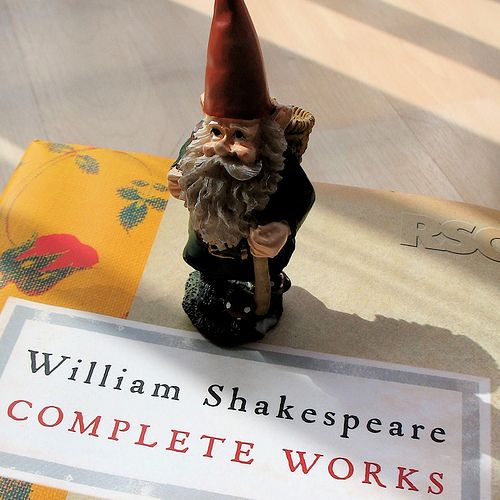
Source: RoryHenry.
A resounding Huzzah!
It's June, and that means it's time once again for Brush Up Your Shakespeare Month, presented by the brilliant Kelly R. Fineman at Writing and Ruminating.
She will be discussing 11 plays (full list here), and promises wickedly keen analysis and commentary, special guests, contests every Friday, and if you like, a dancing bear. There will be much to marvel at, as this adorable poetess serves up a mixed plate of the high brow, low brow, beautiful and bawdy. As is her year round custom, there'll be a bit of the Bard's poetry every Wednesday. She's kicking things off this week with Hamlet and The Tempest.
To whet your appetite, a few foodie quotes from plays she'll be covering in June:
Romeo and Juliet: act 4, scene 2
Tis an ill cook that cannot lick his own fingers.
Henry IV Part I: act 2, scene 1
He hath eaten me out of house and home; he hath put all my substance into that fat belly of his.
A Midsummer Night's Dream: act 4, scene 2
And, most dear actors, eat no onions or garlic, for we are to utter sweet breath; and I do not doubt but to hear them say, it is a sweet comedy. No more words: Away! Go, away!
Henry IV Part I: act 3, scene 1
O, he is as tedious as a tired horse, a railing wife; worse than a smokey house: I had rather live with cheese and garlic in a windmill, far, than feed on cates and have him talk to me in any summer-house in Christendom.
The Comedy Of Errors: act 5, scene 1
Unquiet meals make ill digestions.
Romeo and Juliet: act 4, scene 4
They call for dates and quinces in the pastry.
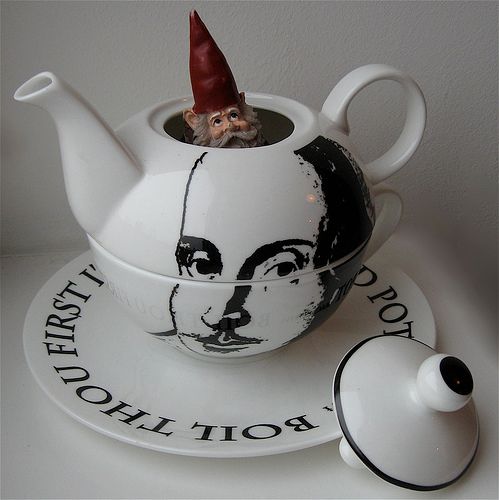
Source: RoryHenry.
Okay now, hie thee hence (with or without your tights, ruffs, farthingales and codpieces)!
Copyright © 2010 Jama Rattigan of jama rattigan's alphabet soup. All rights reserved.
#19 in the Poetry Potluck Series, celebrating National Poetry Month 2010.
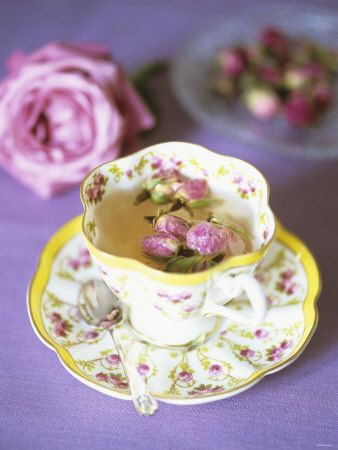
"Tea with Rosebuds in Romantic Cup" by Michael Paul.
(Available as a print here.)
You're just in time for a cup of tea!
Now, if I said, "Jane Austen," "poetic forms," "dead white poets" and garden gnomes, whom would you think of?
Kelly Fineman of course! Like me, you're probably a fan of Writing and Ruminating, where Kelly displays her literary brilliance on a daily basis. For almost three years, I've been reading her amazing blog and I'm not bragging one bit when I say that as a result I'm much smarter ☺. *basks in newfound intelligence*
When it comes to poetry, Kelly knows her stuff. When she features a poem, there's usually a detailed explication, a bit of backstory, personal notes, even illuminating digression. Yes, Kelly loves to digress . . .
For the Potluck, she sent a sonnet about her grandfather's chair. It was prompted by a weekly writing exercise she did with her writing partner, Angela De Groot. They were to begin with, "His chair . . . "
Kelly: The chairs in my dining room belonged to my grandparents, and his chair still sits at the head of the table every night. Interestingly, hubby prefers an armless chair, so it's as if my grandfather has his own place still, even though he died about 25 years ago.
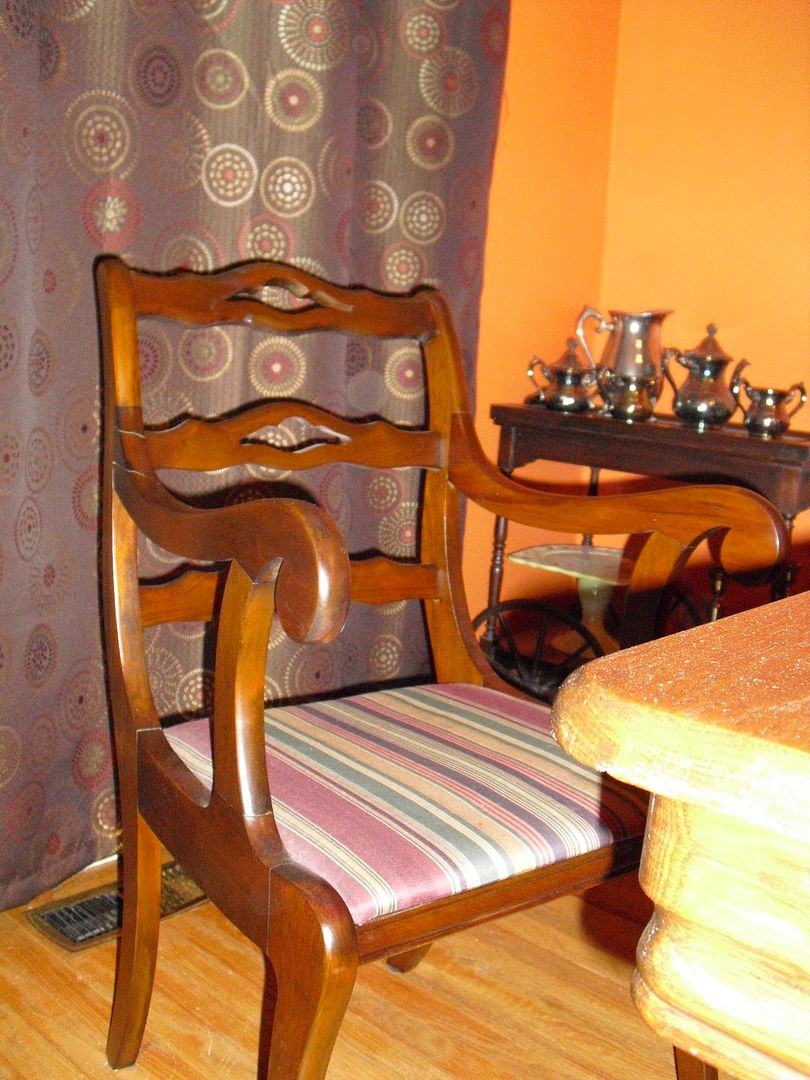
Grandfather's Chair © 2010 Kelly Fineman.
HIS CHAIR
His chair -- the one he sat in when he ate --
Remains his chair a quarter century
After he died, though nobody but me
Realizes this is true; at any rate,
My husband and children, who came too late
Into my life, have no idea that he
Is present at our meals each night as we
Inhabit lesser chairs. No empty plate
Is set (as if Elijah might attend --
It strikes me that St. Paul's a better choice)
I'm certain that they could not comprehend
How large his presence was -- more than his voice
Could fill a room -- his laugh, even his breath,
Live in my memory long past his death.
© 2010 Kelly R. Fineman. All rights reserved.
What a lovely reflection! I like imagining Kelly with this private thought as she sits for dinner. Aren't family heirlooms fascinating? Her sonnet reminded me of visiting Jane Austen's home in Chawton. Interestingly enough, the chairs in the dining room were also "lesser chairs" -- four women sat at this table: Jane, her sister, Cassandra, Jane's mother, and their long-time family friend, Martha Lloyd. Talk about a large presence filling a room! I can just picture Kelly sitting at the table with these ladies and chatting about the events of the day. Kelly, if you could ask Jane just one question, what would it be?
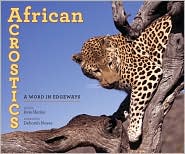 I am fortunate to serve as the poetry coordinator for the CYBILS awards, and in 2009 I was double fortunate because I was also on the nominating panel. This meant I got to read all of the eligible books that were nominated in the poetry category. Among my favorites was a wonderful book by poet Avis Harley, which was "illustrated" with wildlife photographs taken by Deborah Noyes, entitled AFRICAN ACROSTICS: A Word in Edgeways.
I am fortunate to serve as the poetry coordinator for the CYBILS awards, and in 2009 I was double fortunate because I was also on the nominating panel. This meant I got to read all of the eligible books that were nominated in the poetry category. Among my favorites was a wonderful book by poet Avis Harley, which was "illustrated" with wildlife photographs taken by Deborah Noyes, entitled AFRICAN ACROSTICS: A Word in Edgeways.
In addition to providing spectacular photographs of African wildlife including elephants, hippos, crocodiles, giraffes, zebras, impalas and more, the poems include factual information about the animals, all in the form of acrostic poems - a form known by many teachers and children, and one that usually results in rather simplistic poems. Not so with Harley's work - she takes acrostics to a whole new level of clever.
To write an acrostic, you take a word (or phrase) and write it down the left-hand side of the page, then you start each line with the applicable letter. In the case of the poem entitled "A Croc Acrostic", the acrostic is the name of the profiled animal: "CROCODILE". Harley, however, got creative with other animal. The poem about the rhinoceros is not a 10-line poem based on the animal's name. Rather, it is a 16-line poem based on the acrostic "BEAUTY IN THE BEAST".
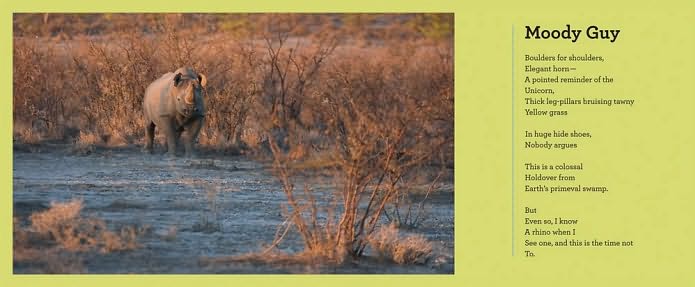
Interior spread showing the rhinoceros poem
The book includes fabulous back matter, including an explanation of what an acrostic is and how to write one as well as short, factual paragraphs on each of the species profiled in the book. A must-have for libraries, poetry lovers, and animal lovers - particularly those interested in the wildlife of Africa.
Scientists in Colombia have been very busy. One group has recently identified 10 new species of living amphibians, nine kinds of frogs plus one type of salamander, and another group has discovered the skeletal remains of a ginormous snake, so large that it could easily have swallowed something as large as a cow. The snake, Titanoboa cerrejonensis was between 42 and 45 feet long, and weighed more than a ton.
The scientists making news today for their discoveries of species in South America (both living and extinct) are following in the shoes of Charles Darwin, who is featured in a number of children's books this year because 2009 marks the 200th anniversary of his birth in 1809. Back on January 19th, Kathleen Krull talked about One Beetle Too Many: The Extraordinary Adventures of Charles Darwin by Kathryn Lasky, illustrated by Matthew Trueman. Later this month, author/illustrator Rosalyn Schanzer will be posting here at I.N.K., and I can only hope she'll be talking about her new book, What Darwin Saw: The Journey That Changed the World, which incorporates information from Darwin's journals.
 But today, I'm talking about Animals Charles Darwin Saw: An Around-the-World Adventure by Sandra Markle, illustrated by Zina Saunders. The book provides a full biography of Charles Darwin's life, with particular focus on his travels and collecting activities while traveling aboard the Beagle, and with his development of what has become known as the theory of evolution (which did not, incidentally, include any reference whatsoever to the evolution of humans).
But today, I'm talking about Animals Charles Darwin Saw: An Around-the-World Adventure by Sandra Markle, illustrated by Zina Saunders. The book provides a full biography of Charles Darwin's life, with particular focus on his travels and collecting activities while traveling aboard the Beagle, and with his development of what has become known as the theory of evolution (which did not, incidentally, include any reference whatsoever to the evolution of humans).
Want to see one of the two-page spreads so you can be completely wowed by the artwork? I'll bet you do, so here's one:

Each two-page spread contains amazing images, a decent chunk of text, and a text box that includes an interesting detail or bit of trivia.
The book explains what Darwin studied, how he got interested in science, and what his duties aboard the Beagle entailed. When he was in South America, he discovered ancient skeletons of extinct species, which caused him to question what he'd been taught: that animals were created as is, and always had been that way. Later, in the Galapagos Islands, he noted similarities and differences in species of birds, lizards, and tortoises living on various islands. He eventually concluded that the various species had adapted to suit their specific habitat, thereby laying the foundation for his later theories.

The book includes useful tools including a note to parents and teachers, a table of contents, a map of the Beagle's voyage, a glossary, a list of additional resources, and a handy dandy index. In short, it's a teacher's dream, and makes using the book as a source super-easy.
 Ever since I read Moses and Henry's Freedom Box, I've been excited about Kadir Nelson's artwork. And ever since I attended the SCBWI conference in LA, I've been looking forward to getting my hands on Kadir Nelson's first solo book project, We Are the Ship: The Story of Negro League Baseball, ("words and paintings by Kadir Nelson"). The book takes its title from the motto of the Negro National League, taken from a quote from Rube Foster, the League's founder: "We are the ship; all else the sea." About ten days ago, I found the book in my local bookstore. And now that I've read it, I want to shout about it.
Ever since I read Moses and Henry's Freedom Box, I've been excited about Kadir Nelson's artwork. And ever since I attended the SCBWI conference in LA, I've been looking forward to getting my hands on Kadir Nelson's first solo book project, We Are the Ship: The Story of Negro League Baseball, ("words and paintings by Kadir Nelson"). The book takes its title from the motto of the Negro National League, taken from a quote from Rube Foster, the League's founder: "We are the ship; all else the sea." About ten days ago, I found the book in my local bookstore. And now that I've read it, I want to shout about it.

From the cover art to the rich brown endpapers to the forward by Hall of Famer Hank Aaron to Nelson's folksy narration of the text to the glorious paintings inside the book (including one amazing double fold-out spread showing the complete lineup for the first Colored World Series), to the author's note to the bibliography to the index, this book is a gem.
Nelson organized the book into ten chapters (nine innings, plus another chapter called "extra innings"). The only thing this book is lacking is (and I hate to be picky, but here it is): a Table of Contents. Just so you get an idea how the book is organized and what the scope is, here's what the annotated Table of Contents would look like:
Foreword by Hank Aaron
p. 1 1st inning: Beginnings Tells of the start of baseball and of the participation of African Americans
p. 17 2nd inning: A Different Brand of Baseball: Negro League Game Play Explains how Negro League play differed from the white leagues with more showmanship and speed, and that stats weren't always kept (and/or weren't always accurate)
p. 23 3rd inning: Life in the Negro Leagues Talks about the traveling conditions, both on the road and off, including discussion of segregation and field conditions
p. 31 4th inning: Racket Ball: Negro League Owners The effect of the depression on baseball and how it was funded (sometimes not quite on the right side of the law), and the development of night games
p. 41 5th inning: The Greatest Baseball Players in the World: Negro League All-Stars Stories about some of the greatest Negro League players, going well beyond household names like Satchel Paige
p. 53 6th inning: Latin America: Baseball in Paradise A discussion of the many Negro League players from Latin America, and of the Negro League tours in Latin America
p. 57 7th inning: Good Exhibition: The Negro Leagues vs. the White Leagues Barnstorming, playing against the House of David, and more
p. 63 8th inning: Wartime Heroes: World War II and the Negro League All-Star Game Some information about African Americans in the service and the upswing of the Negro League All-Star game and the East-West game and how it affected integration.
p. 69 9th inning: Then Came Jackie Robinson Jackie Robinson's decision to play for the Brooklyn Dodgers
p. 77 Extra innings: The End of the Negro Leagues The gradual re-integration of minority players into the major leagues and how it decimated the Negro League.
p. 79 Negro Leaguers Who Made it to the Major Leagues A list of names
p. 79 Negro Leaguers in the National Baseball Hall of Fame A list of names
p. 80 Author's Note How Kadir Nelson got interested in the topic, did his research, created the art, and wrote the book, with a bit of inspiration to boot.
p. 81 Acknowledgements
p. 82 Bibliography & Filmography
p. 83 Endnotes
p. 86 Index
This book is a must-have for (1) all libraries, (2) all baseball fans, (3) all Kadir Nelson fans. That's a lot of categories, but it's true.
We Are The Ship explains what the Negro Leagues were, and what it felt like to be a part of them, including being the brunt of name-calling and being subjected to the thousand cuts of segregation (not all of them being small cuts, by the way). The narrator's matter-of-fact tone and folksy stories is a pleasant companion throughout the text. He tells how the business of the leagues was conducted is examined. He talks about the heroes of the league (many of them in the 5th inning, which features breathtaking pictures). Throughout, the narrator's voice sounds very much like an old Negro League player talking about people he actually knew, good points, bad points, and all.

If you'd like a further look inside the book, Kadir Nelson offers one on his site (it's where I took these images from). But if you're a librarian or a baseball fan or someone who, like me, has a bit of a crush on Kadir Nelson, then you need to BUY THIS BOOK. Now. Before it wins awards next year. Because it's going to win them.
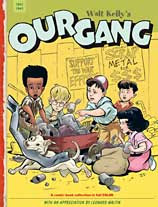
Walt Kelly’s Our Gang. Vol. 1, 1942-1943
Author: Walt Kelly
Publisher: Fantagraphics Books
ISBN 10: 1-56097753-1
ISBN 13: 978-1-56097753-7
Walt Kelly is famous for his now-classic Pogo newspaper comic strip from 1948 until his death in 1973. Most cartoon fans know that Kelly began as an animator for Walt Disney, and that he wrote and drew funny-animal and fairy-tale comic books from 1941 until 1948. He actually began Pogo in comic-book form in 1941. Much of Kelly’s comic-book art has been reprinted over the last two decades, especially his Disney comics covers showing Mickey Mouse and Donald Duck in his own art style.
Kelly also wrote and drew a human comic-book series during the 1940s, around the Our Gang children film stars. Movie historian Leonard Maltin describes in an introductory “appreciation” how Dell/Western Publishing licensed in 1942 the rights to produce a comic book featuring all the MGM movie short series like the Tom & Jerry cartoons, and they chose the Our Gang stories to lead off the comic book – and hired cartoonist Kelly to produce them. MGM had bought Our Gang from the Hal Roach Studio in 1938, and by 1942 had lost interest in them, so Kelly had the creative freedom to interpret the kids in his own way. The 8- to 14-page stories in these first eight issues were very close to MGM’s last Our Gang one-reelers, based on publicity stills of the child actors and following the movies’ stereotypes. Maltin, and Kelly collector-historian Steve Thompson in his introduction, promise that later stories of the 59 in the series will show how Kelly evolved, having the movie Gang grow older and be replaced with new characters who were Kelly’s own, with realistic personalities rather than stereotypes.

This collection has several laudable goals: to show that Kelly could create excellent realistic human-character stories as well as funny-animal humor; to restore a missing dimension of the Our Gang works for those movies’ fans; and to present a nostalgic glimpse of children’s lives in America in the 1940s. As Steve Thompson says, “Not for them the over-organized and regimented sports, dance and music activities of today’s youth. In those days before ‘stranger danger’ and almost daily reports of child abductions, in all but the largest cities during summer, kids could disappear after breakfast, possibly return for lunch, and then vanish again until supper, without panicking their parents.” (I can confirm this. I am in my late sixties now, and I grew up in Los Angeles rather than an Eastern small town, but I had the same juvenile freedom to just “mess around” outdoors all day with my playmates as long as we stayed out of trouble.) It may be personal nostalgia for my own youth, but I found Walt Kelly’s Our Gang vol. 1 to be thoroughly delightful.











 I am fortunate to serve as the poetry coordinator for the
I am fortunate to serve as the poetry coordinator for the 
 But today, I'm talking about
But today, I'm talking about 

 Ever since I read Moses and Henry's Freedom Box, I've been excited about Kadir Nelson's artwork. And ever since I attended the SCBWI conference in LA, I've been looking forward to getting my hands on Kadir Nelson's first solo book project, We Are the Ship: The Story of Negro League Baseball, ("words and paintings by Kadir Nelson"). The book takes its title from the motto of the Negro National League, taken from a quote from Rube Foster, the League's founder: "We are the ship; all else the sea." About ten days ago, I found the book in my local bookstore. And now that I've read it, I want to shout about it.
Ever since I read Moses and Henry's Freedom Box, I've been excited about Kadir Nelson's artwork. And ever since I attended the SCBWI conference in LA, I've been looking forward to getting my hands on Kadir Nelson's first solo book project, We Are the Ship: The Story of Negro League Baseball, ("words and paintings by Kadir Nelson"). The book takes its title from the motto of the Negro National League, taken from a quote from Rube Foster, the League's founder: "We are the ship; all else the sea." About ten days ago, I found the book in my local bookstore. And now that I've read it, I want to shout about it.



Love Michelle’s art